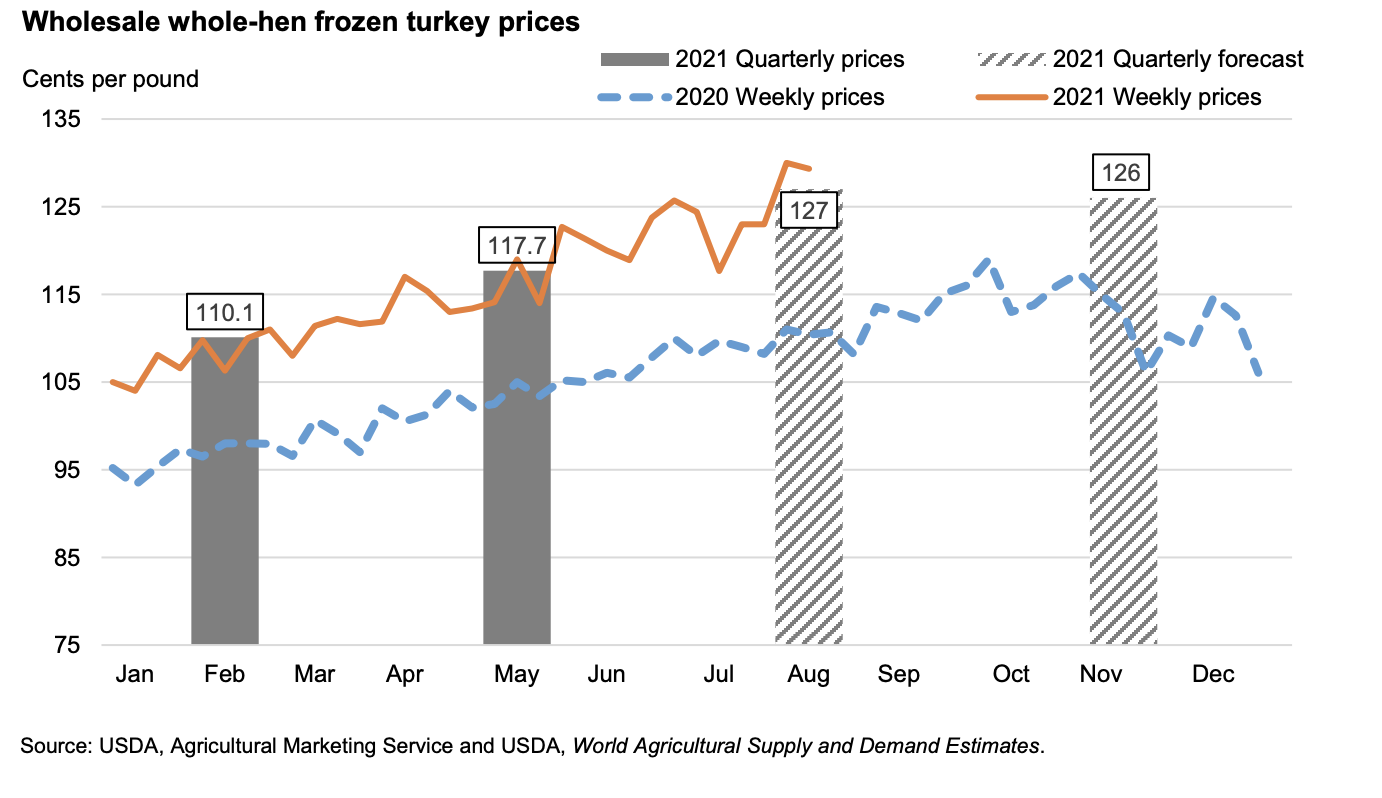Aug. 20, 2021
Poultry production bottlenecks may mean another tough year for holiday turkey lovers
By Ryan McGeeney
U of A System Division of Agriculture
Fast Facts:
- Whole turkey, value-added production down in 2021
- Most popular sizes, 14 & 16 lbs., expected to be less available
- Value-added prices significantly higher
(552 words)
LITTLE ROCK — While the heat of August may cause you to move the idea of holiday season dinners to the very bottom of your priority list, family cooks take note: This may be another difficult year for putting together the perfect Thanksgiving or Christmas turkey dinner.
James Mitchell, extension agricultural economist for the University of Arkansas System Division of Agriculture, said two major factors will affect the price and availability of whole turkeys and other poultry products this holiday season.
The first is overall turkey production,” Mitchell said. The U.S. Department of Agriculture is currently forecasting a 1.5 percent decline in turkey production from 2020, falling by 84 million pounds. The decline, coupled with gradually shrinking cold storage inventories, has led to a 13 percent rise in the cost of frozen whole hens, averaging about $1.16/lb.
“Much of this reduction came during the first half of the year,” Mitchell said. “In many ways, it was a spillover effect from the struggles the industry experienced during the pandemic in 2020.”
As the COVID-19 pandemic raced across the United States in March of 2020, many businesses shuttered, laid off non-essential employees or tasked employees to work remotely when possible. In industries such as agriculture, where remote work is often unfeasible, production sometimes slowed to a crawl as COVID infections caused facilities to close temporarily. This led to significant bottlenecks in timber, poultry and beef production, among other sectors.
“To finish out 2021, USDA is forecasting only fractionally lower production during the fourth quarter of the year,” Mitchell said. “So, the general outlook is to see fewer total pounds available this year. For me, it’s still difficult to say how noticeable this decline in supply will be at the grocery store come holiday season.”
In 2019, Arkansas produced about 576 million pounds of turkey, at a value of more than $333 million to the state.
Mitchell said the second factor, which may prove to be more significant than the first, is that the nature of meat and poultry processing in the age of COVID could mean reduced availability of specific products, such as lighter weight fresh turkeys and value-added products such as breast meat.
More than just COVID
“The labor problem is both COVID-19 induced and follows the trend of an aging and
declining rural population where these processing plants are located,” Mitchell said.
“Throughout the pandemic, the cost of production for meat processing has been significantly
higher. This shouldn’t be a surprise by now. Think of the significant investments
that processors have had to make to keep workers safe and plants operating.
“Does this mean that consumers will be squeezed this holiday season? My reaction is, not as much as some headlines might suggest,” he said. “Retail grocery stores are in the business of moving products, and they will continue to do that through features and deals like buy-one-get-one, and so on.”
While both 14 lb. and 16 lb. turkeys — the most popular sizes sold in retail groceries in the United States — may become noticeably more expensive and somewhat less available, prices in parted-out birds are already significantly higher. Since April, wholesale breast prices have increased 73 percent, Mitchell said.
Mitchell said these kinds of price and availability challenges are likely to affect more than the prized holiday birds this season.
“These issues are not unique to turkey,” he said. “We have seen similar issues with boneless hams and value-added pork. Some proactive planning from our holiday cooks is probably warranted.”
To learn about extension programs in Arkansas, contact your local Cooperative Extension Service agent or visit www.uaex.uada.edu. Follow us on Twitter and Instagram at @AR_Extension. To learn more about Division of Agriculture research, visit the Arkansas Agricultural Experiment Station website: https://aaes.uark.edu. Follow on Twitter at @ArkAgResearch. To learn more about the Division of Agriculture, visit https://uada.edu/. Follow us on Twitter at @AgInArk.
About the Division of Agriculture
The University of Arkansas System Division of Agriculture’s mission is to strengthen agriculture, communities, and families by connecting trusted research to the adoption of best practices. Through the Agricultural Experiment Station and the Cooperative Extension Service, the Division of Agriculture conducts research and extension work within the nation’s historic land grant education system.
The Division of Agriculture is one of 20 entities within the University of Arkansas System. It has offices in all 75 counties in Arkansas and faculty on five system campuses.
Pursuant to 7 CFR § 15.3, the University of Arkansas System Division of Agriculture offers all its Extension and Research programs and services (including employment) without regard to race, color, sex, national origin, religion, age, disability, marital or veteran status, genetic information, sexual preference, pregnancy or any other legally protected status, and is an equal opportunity institution.
# # #
Media contact:
Ryan McGeeney
Communications Services
University of Arkansas System Division of Agriculture
Cooperative Extension Service
(501) 671-2120
rmcgeeney@uada.edu
